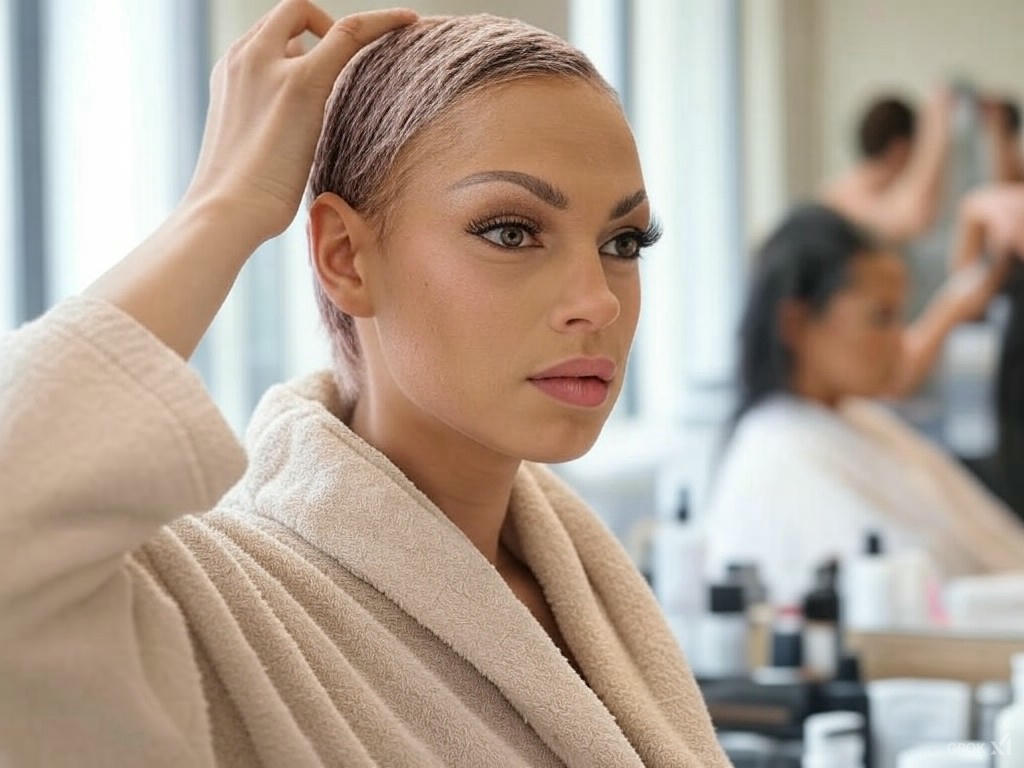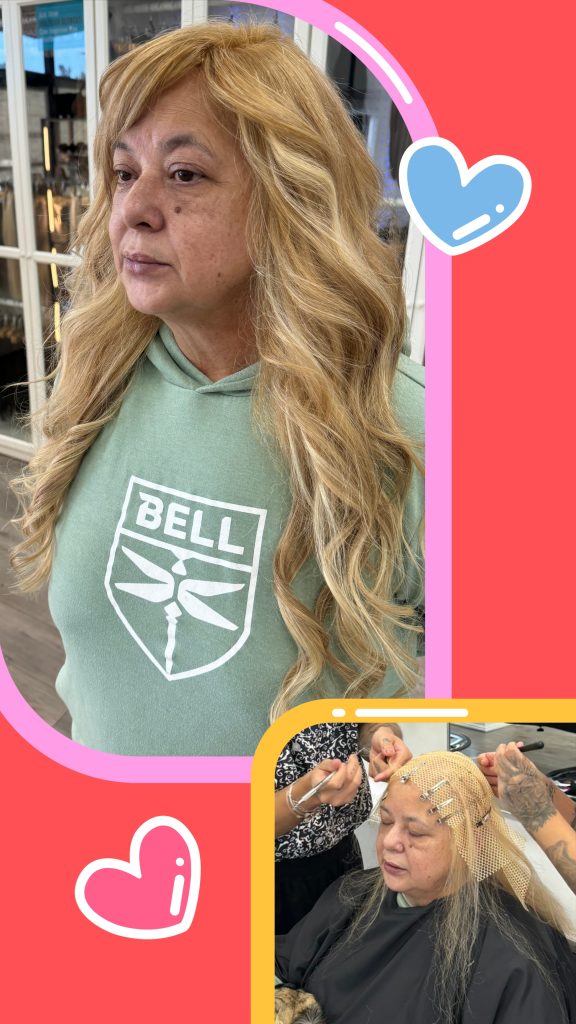1500+ ★★★★★ REVIEWS
Post-Gender Transition Hair Loss: Causes, Solutions, and Prevention

Hair loss during or after gender transition is a common yet often unexpected experience for many individuals, influenced by hormonal shifts, stress, or medical interventions inherent to the process. Whether triggered by hormone replacement therapy (HRT) like testosterone or estrogen, surgical procedures, or the emotional toll of transitioning, this hair thinning can mirror conditions such as androgenetic alopecia or telogen effluvium, as noted by Healthline. Fortunately, a blend of medical solutions—like minoxidil or nutritional support—and non-medical options, such as wigs and toppers from Hottie Hair Salon & Extensions Store, alongside preventive strategies, can address these changes effectively. This section explores the unique causes of post-transition hair loss and offers practical, affirming solutions to restore confidence and hair health.
What Causes Hair Loss After Gender Transition?
Hair loss after gender transition often stems from hormonal fluctuations, stress, or a genetic predisposition amplified by the transition process. For transgender men on testosterone therapy, elevated androgen levels can trigger androgenetic alopecia, leading to thinning at the crown or a receding hairline, as explained by Cleveland Clinic. Transgender women using estrogen and anti-androgens may experience telogen effluvium due to hormonal stabilization or stress from surgery and recovery, per Healthline. Additionally, nutritional deficiencies from rapid weight changes or the physical toll of procedures like gender-affirming surgery can exacerbate shedding, while emotional stress—a common part of transitioning—further disrupts the hair growth cycle, according to Medical News Today. These factors interplay uniquely for each individual, making awareness key to managing post-transition hair loss.
1. Hormonal Changes
Hormone Replacement Therapy (HRT) plays a significant role in gender transition. However, it can sometimes contribute to hair thinning or loss, depending on the individual’s response.
- Trans Women (MTF): Estrogen and anti-androgens (such as spironolactone or finasteride) can slow male-pattern baldness but may not fully reverse prior hair loss.
- Trans Men (FTM): Testosterone therapy can trigger male-pattern baldness, especially in those with a genetic predisposition.
Source: American Academy of Dermatology on Hormonal Hair Loss
2. Genetic Factors
Individuals with a family history of androgenetic alopecia (male or female pattern baldness) may experience hair loss regardless of HRT.
3. Stress and Medical Treatments
- Surgical procedures such as facial feminization or masculinization surgery can temporarily stress the body, leading to telogen effluvium (temporary hair shedding).
- Emotional and psychological stress can exacerbate hair thinning.
When Does Hair Loss Occur After Transition?
Hair loss after gender transition typically emerges within weeks to months of initiating hormone replacement therapy (HRT) or undergoing significant transition-related events, though the timeline varies by individual and trigger. For transgender men, androgenetic alopecia from testosterone may begin 3-6 months into HRT as androgen levels rise, gradually thinning hair over time, per Cleveland Clinic. Transgender women might notice telogen effluvium-related shedding 2-4 months after starting estrogen or following surgery, as the body adjusts to hormonal shifts or stress, according to Healthline. Emotional or nutritional stressors tied to transition milestones, like coming out or recovery periods, can also delay onset, with hair loss peaking months later, as noted by Medical News Today. Monitoring these changes early helps tailor timely solutions.
Medical and Non-Medical Solutions for Hair Loss
Hair loss during or after gender transition can be effectively managed with a combination of medical and non-medical solutions, tailored to address both the physical and emotional aspects of this experience. Medically, treatments like minoxidil can stimulate regrowth for androgenetic alopecia in transgender men, while supplements tackle deficiencies linked to telogen effluvium in transgender women, as supported by Cleveland Clinic. Non-medically, options such as mesh integration, hair toppers, and wigs from Hottie Hair Salon & Extensions Store offer immediate coverage and confidence, blending seamlessly with natural hair or providing full styling versatility via Hottie Hair. These approaches together empower individuals to navigate hair loss with practical, affirming solutions suited to their transition journey.
Medical Solutions
Medical solutions for post-transition hair loss target hormonal shifts and deficiencies with proven treatments like minoxidil, hormone adjustments, and nutritional supplements, offering effective regrowth options, per Healthline.

1. Minoxidil (Rogaine)
Minoxidil (Rogaine)
Minoxidil, sold as Rogaine, is a topical treatment that promotes hair regrowth by stimulating follicles, making it a go-to for transgender men facing androgenetic alopecia post-testosterone therapy. Applied daily, it can show results in 3-6 months, though continuous use is needed to sustain growth, per Cleveland Clinic. Available in 2% and 5% strengths, it’s a practical, over-the-counter option with minimal side effects like scalp irritation, as noted by Healthline.
2. Finasteride & Dutasteride
Finasteride and Dutasteride are effective treatments for post-gender transition hair loss, as they help reduce dihydrotestosterone (DHT) levels, the hormone responsible for hair thinning and loss. These medications can be particularly beneficial for transgender women experiencing androgenic alopecia by slowing hair loss and promoting regrowth. However, it’s essential to consult with a healthcare provider to determine the most suitable option and dosage for individual needs.
3. Platelet-Rich Plasma (PRP) Therapy
Platelet-Rich Plasma (PRP) Therapy is a cutting-edge treatment for hair loss that uses the body’s natural healing properties to stimulate hair growth. During the procedure, a small amount of blood is drawn, processed to concentrate the platelets, and then injected into the scalp. These platelets release growth factors that enhance hair follicle function and promote new hair growth. PRP therapy is a non-surgical solution suitable for both men and women experiencing thinning hair or early-stage hair loss, offering natural and effective results.
Source: American Academy of Dermatology on PRP for Hair Loss
4. Hair Transplants
Hair transplants are a permanent solution for hair loss that involve relocating hair follicles from a donor area, typically the back or sides of the head, to thinning or balding areas. There are two main techniques: Follicular Unit Transplantation (FUT), where a strip of scalp is removed and divided into grafts, and Follicular Unit Extraction (FUE), where individual follicles are harvested and transplanted. Both methods provide natural-looking results by strategically placing hair to mimic natural growth patterns. Hair transplants are an effective option for those seeking long-term restoration and fuller hair.
Non-Medical Solutions
Non-medical solutions like wigs, toppers, and mesh integration from Hottie Hair Salon & Extensions Store provide instant coverage and style, boosting confidence during hair loss, per Hottie Hair.

1. Mesh Integration System
The Mesh Integration System is a non-surgical hair enhancement solution designed for individuals with thinning hair or partial hair loss. This method involves securing a breathable, mesh-like base to the scalp, which blends seamlessly with existing hair. High-quality human hair is then attached to the mesh, matched in color and texture for a natural appearance. The system allows for versatile styling and requires regular maintenance but offers a comfortable and durable solution for achieving fuller, voluminous hair without surgery. Hottie Hair Salon & Extensions Store offers a free consultation for mesh integration services.
Learn more: Hottie Hair Mesh Integration
2. Hair Toppers
Hair toppers are a versatile and lightweight solution for adding volume and coverage to thinning hair or specific areas of hair loss. Designed to blend seamlessly with your natural hair, they come in various sizes, lengths, and colors to provide a natural-looking boost in fullness. At Hottie Hair, we offer premium-quality hair toppers made from 100% human hair, ensuring a perfect match and comfortable wear. Our expert stylists help you find the ideal topper to enhance your look with confidence and style.
Find the perfect topper: Hottie Hair Toppers
3. Wigs and Extensions
Wigs and extensions are fantastic options for instantly transforming your look, adding length, volume, or even a splash of color without commitment. Whether you’re dealing with hair loss or simply craving a new style, these versatile solutions offer endless possibilities. At Hottie Hair, we provide a wide selection of premium wigs and extensions made from 100% human hair for the most natural appearance and feel. Our skilled team helps you find the perfect match and ensures a seamless blend, giving you the confidence to rock any look effortlessly.
Schedule a free consultation: Hottie Hair Extensions
4. Scalp Micropigmentation (SMP)
Scalp Micropigmentation (SMP) is a non-surgical cosmetic procedure that creates the illusion of fuller hair by replicating the appearance of hair follicles using tiny, specialized pigments. Ideal for individuals experiencing thinning hair, receding hairlines, or complete baldness, SMP delivers a natural-looking, shaved-head effect or enhances density in sparse areas. The treatment is customizable to match your hair color and desired style. It’s a low-maintenance solution that offers long-lasting results and renewed confidence.
Preventing and Managing Hair Loss

Preventing and managing hair loss involves a holistic approach that prioritizes overall health and well-being. A balanced diet rich in essential nutrients, such as vitamins, minerals, and proteins, supports strong and healthy hair growth. Gentle hair care practices, including using mild shampoos, avoiding excessive heat styling, and minimizing harsh chemical treatments, help maintain hair integrity and prevent breakage. Additionally, managing stress through relaxation techniques, exercise, and mindfulness can significantly reduce hair shedding linked to hormonal imbalances. By nurturing your body and mind, you can effectively prevent and manage hair loss.
1. Hair-Friendly Diet & Hydration
A hair-friendly diet and proper hydration are fundamental for maintaining healthy, strong hair and preventing hair loss. Consuming nutrient-rich foods, including lean proteins, leafy greens, nuts, and seeds, provides essential vitamins and minerals like biotin, zinc, iron, and omega-3 fatty acids that promote hair growth and strength. Staying well-hydrated supports overall scalp health, ensuring hair follicles receive the nutrients they need. By maintaining a balanced diet and drinking plenty of water, you can enhance hair vitality and reduce the risk of thinning and breakage.
2. Gentle Hair Care Routine
A gentle hair care routine is essential for maintaining healthy hair and preventing unnecessary breakage or hair loss. This includes using mild, sulfate-free shampoos and moisturizing conditioners that nourish the scalp and hair without stripping natural oils. Limiting the use of heat styling tools and harsh chemical treatments helps preserve hair strength and elasticity. Additionally, gentle brushing with a wide-tooth comb and avoiding tight hairstyles reduce tension on the hair shaft. By adopting a gentle approach, you can protect your hair’s integrity and promote long-term health and growth.
3. Stress Management
Stress management plays a crucial role in preventing and reducing hair loss, as prolonged stress can trigger conditions like telogen effluvium, which causes excessive shedding. Incorporating relaxation techniques such as deep breathing, meditation, yoga, or regular physical activity can help lower stress levels and improve overall well-being. Adequate sleep and time for self-care also contribute to stress reduction, allowing your body to heal and function optimally. By managing stress effectively, you can minimize its impact on your hair health and support healthier hair growth.
Post-Gender Transition Hair Loss Frequently Asked Questions (FAQ)
1. What causes post-gender transition hair loss?
Post-gender transition hair loss is often caused by hormonal changes that affect the hair growth cycle. Testosterone therapy, in particular, can lead to androgenic alopecia, which is thinning or loss of hair due to sensitivity to dihydrotestosterone (DHT). While hair loss is a common side effect, it varies depending on individual factors such as genetics and overall health.
2. How can I prevent hair loss during my gender transition?
Preventing hair loss during a gender transition involves a combination of medical and non-medical approaches. Consulting with a healthcare provider for hormonal management can help, while adopting a hair-friendly diet, using gentle hair care products, and managing stress can further reduce the risk of hair loss. Non-medical options like hair toppers or mesh integration systems can provide instant volume and coverage.
3. Can I use Finasteride or Dutasteride after transitioning?
Finasteride and Dutasteride can be used to treat post-transition hair loss, as they help block the hormone DHT, which is responsible for hair thinning. These medications can be effective for transgender women experiencing androgenic alopecia, but it’s essential to discuss these options with a healthcare provider to ensure they align with your transition goals.
4. What is the best diet for supporting hair health during transition?
A nutrient-rich diet is crucial for maintaining healthy hair. Foods rich in biotin, zinc, iron, and omega-3 fatty acids promote stronger hair growth. Consider adding lean proteins, leafy greens, nuts, and seeds to your diet, along with staying well-hydrated to support your hair follicles and overall scalp health during your transition.
5. Are there non-medical solutions to manage post-transition hair loss?
Yes, non-medical solutions like hair toppers, wigs, and mesh integration systems offer great ways to manage hair loss without resorting to medications or surgery. These options provide instant volume and coverage, giving you the confidence to embrace your look while allowing your natural hair to grow and thrive.
6. How can mesh integration help with hair loss after transition?
Mesh integration is a non-surgical method that involves attaching a breathable mesh base to the scalp, which blends with your natural hair. High-quality human hair is then integrated into the mesh, giving you a seamless, natural-looking solution to enhance volume and coverage. At Hottie Hair, we offer premium mesh integration systems that can help you manage hair loss with comfort and style.
7. Can I use hair extensions if I experience thinning hair after transitioning?
Hair extensions are a fantastic option for adding volume and length to thinning hair. At Hottie Hair, we offer high-quality extensions made from 100% human hair, ensuring a natural and seamless look. Extensions can be customized to match your hair color and texture, providing a non-permanent solution to boost fullness while you work on hair regrowth.
8. How can stress impact hair loss during my transition?
Stress can contribute to hair loss by triggering conditions like telogen effluvium, where hair prematurely enters the shedding phase. Managing stress through regular exercise, meditation, yoga, or simple relaxation techniques can help reduce the impact on your hair. Reducing stress is essential for both emotional well-being and the health of your hair during your transition.
9. Is Scalp Micropigmentation (SMP) a good option for post-gender transition hair loss?
Scalp Micropigmentation (SMP) is an excellent non-surgical solution for post-transition hair loss. It creates the appearance of thicker, fuller hair by applying tiny pigment dots on the scalp, mimicking the look of hair follicles. SMP is a low-maintenance treatment that can enhance your confidence and provide a natural look while your hair continues to grow.
10. How can Hottie Hair help with post-transition hair loss?
At Hottie Hair, we understand the unique challenges of post-gender transition hair loss and offer a variety of solutions to help you feel your best. From premium wigs and extensions to custom mesh integration systems, our team is here to help you find the perfect product that matches your needs and style. We provide high-quality, natural-looking solutions that will give you the confidence to embrace your look during your transition.

Hair loss during gender transition can be challenging, but with the right solutions, individuals can regain their confidence. Whether through medical treatments, non-surgical options like mesh integration, or premium wigs and extensions, there are effective ways to manage hair loss. Visit Hottie Hair Salon & Extensions Store for a free consultation on expert hair restoration solutions.
You must be logged in to post a comment.